
Islam has two characteristics: Universality and dynamism. By the first
all differences of race and colour are extinguished. by the second he made
fabulous progress in all ages through the three known continents of the
world. Islam has its adherents in distant Japan, in China, Malaya, India,
South Africa as well as in countries like those of Northern Africa which
are predominantly Moslem. Yet it is in Egypt that the intellectual and
moral centre of Islam is to be found; it is to the theologians of Egypt
that Moslems turn for guidance in matters of faith and conduct; it is from
the jurists and theologians in Egypt that they seek interpretations of
the sacred Koranic law.
The two grand principles of the Mohammedan faith are: -"There is no deity but God" and "Mohammed is the apostle of God". This simple creed is completed by a code of conduct which is drawn from the Koran, the sayings of the Prophet, the early traditions of his disciples, and from analogy. 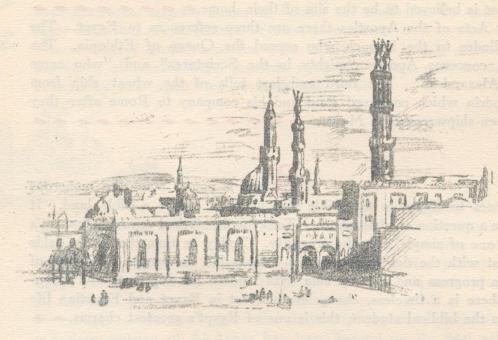 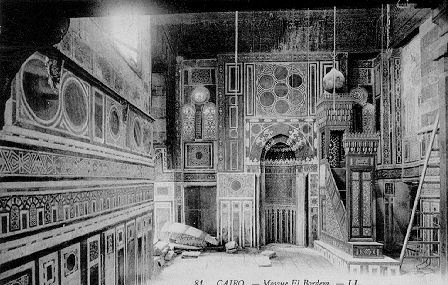
The main obligations laid down by the ritual and moral laws of Islam are prayer, aims-giving, fasting and pilgrimage. The liturgical hours for prayer are five in number: sunset, night-fall, day-break, noon and mid-afternoon. The times are announced by the call to prayer chanted from the minarets of mosques but the prayers themselves may be said either within or without the mosque. Indeed, as no one who visits Egypt can fail to observe, prayers are often said at home or in the fields. 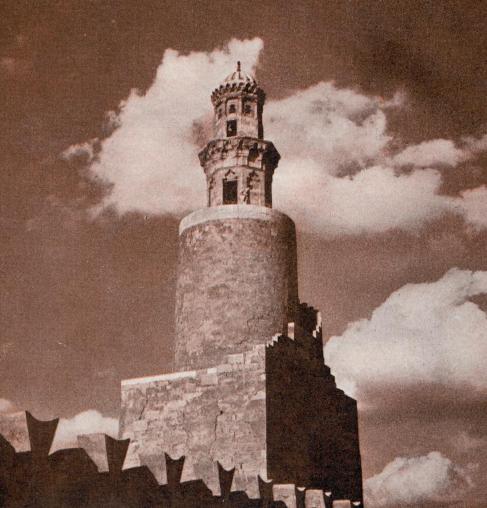 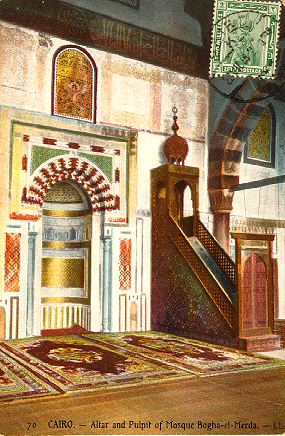
Alms-giving is very generally practised by the Moslems of Egypt. At each of the great festivals and on many other occasions food, clothes and money are distributed to the poor and wealthy people invariably commemorate a wedding or birth in their families by providing meals or gifts for those less fortunate. The Ministry of Wakfs (Pious Foundations) disposes of large sums left by endowments the income of which is devoted to philanthropic and religious work. Of late years "organized" charity has greatly developed in Egypt. Two of the largest Hospitals in the world are run by charitable societies, while popular kitchens, where free or under-cost meals are supplied, and seaside camps for town children are supported by public contributions. The pilgrimage to Mecca is performed each year by many thousands of
Egyptian Moslems. A generation or so ago it was a long and often perilous
undertaking. Now however with an air service from Egypt to the Holy City
the pilgrim need only be absent from home for some two or three weeks.
The Holy Carpet. the departure of which is a picturesque accompaniment
to the yearly pilgrimage, is woven and embroidered in Cairo by specially
trained workers. Preceded by heralds and musicians the Holy Carpet, carried
on the back of a camel specially bred and reserved for the purpose, leaves
Cairo amid great ceremony and rejoicings. Its return, when the pilgrimage
is completed, is the occasion of further rejoicings and a public holiday.
 The mouled of Tantah's patron saint is very largly attended and the town, at mouled time, presents a curious aspect with its outskirts covered by row upon row of tents and awnings. The ritual ceremonies and festivals referred to above are of course common to every nation professing the religion of Islam. They would not therefore suffice in themselves to make of Egypt the centre of Islam' Nor perhaps would Egypt be such a centre were it not for the existence and influence of Al-Azhar. For nearly a thousand years the university or, more accurately, the
collegiate mosque of Al-Azhar has been known as the best school of Arabic
literature, Moslem theology and jurisprudence. At first sight it may seem
curious that these three subjects should be bracketed together ; but it
must be remembered that Arabic is not-only the language spoken in Egypt
and other countries, it is also the medium by which the Koran was revealed.
As such it has acquired a sacred character, a thorough knowledge of Arabic
being an essential preliminary to a thorough knowledge of the Koran. It
therefore follows that Arabic literature and Moslem theology are correlated
subjects. The same may be said of jurisprudence. The religion of Islam
is more than a faith to which its followers subscribe; it is a social system
and it legislates not only in matters of belief but in social matters such
as marriage, divorce, right of property, inheritance and successions. Jurisprudence
is thus
Al-Azhar was founded in A.D. 970. It was intended to be the chief mosque
or official place of worship for the then new city of Cairo. Not until
some years later did it become an educational centre. Since then however
it has attracted students from every part of the Moslem world. Indian,
Turkish, Malay, Chinese and Japanese students are among the
The Arabic language and all subjects connected with the faith of Islam
were for many centuries the sole curriculum of AI-Azhar. At the present
day it may be said that a complete Al-Azhar training is a complete education.
Secular sciences are in honour, the study of foreign languages is encouraged.
Future teachers are trained not only in the subjects they will be called
upon to teach but also in the best methods of teaching. These and other
reforms have involved an extension of premises and several departments
of the University's activities are now housed in various parts of Cairo
while, continuing a tradition of the past, affiliated colleges have been
opened in several of the provincial towns of Egypt.
Egypt is a land of Islam. Perhaps that it why it is also a land of tolerance,
a land in which no man is prevented from worshipping God in such manner
as his faith dictates, where freedom of conscience reigns, where religious
persecution is unknown.
|
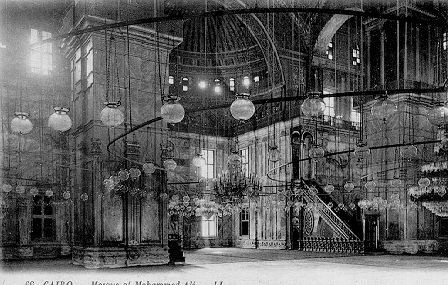
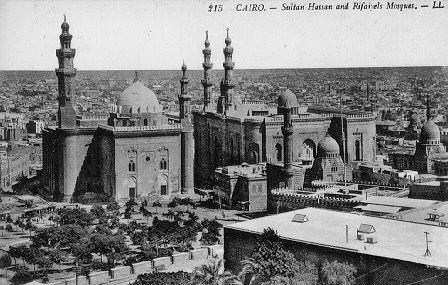
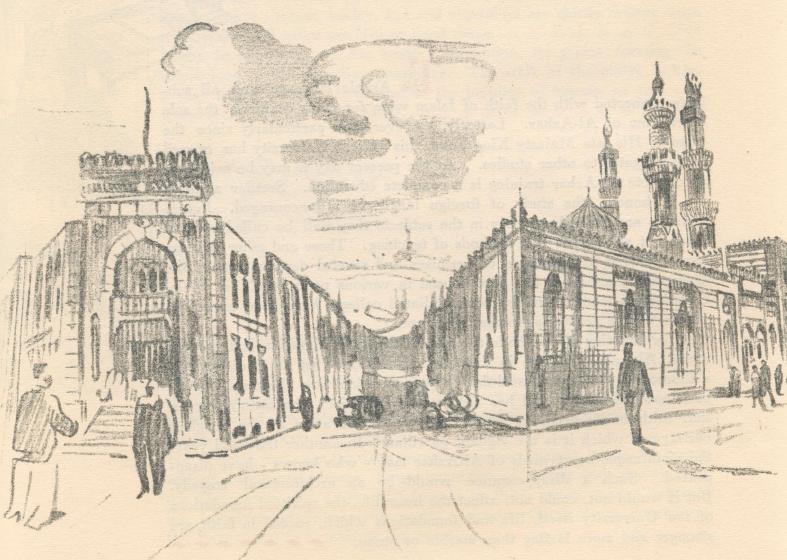
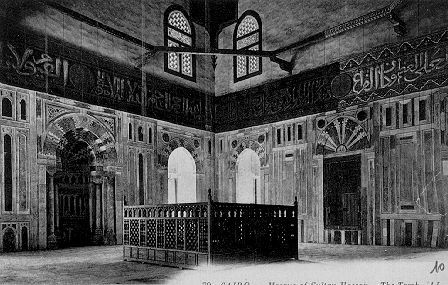 faith;
it still has as its aim and object, the maintenance of that faith in its
primitive purity and the preservation of the religious heritage of which
it is the vigilant guardian. In another thousand years the picturesque
court-yards of Al-Azhar may - who knows - have disap peared. Such a disappearance
would be an architectural tragedy. But it would not, could not, affect
the inner life, the spiritual foundations of the University itself, life
and foundations which, rooted in faith, are stronger and more lasting than
marble or stone.
faith;
it still has as its aim and object, the maintenance of that faith in its
primitive purity and the preservation of the religious heritage of which
it is the vigilant guardian. In another thousand years the picturesque
court-yards of Al-Azhar may - who knows - have disap peared. Such a disappearance
would be an architectural tragedy. But it would not, could not, affect
the inner life, the spiritual foundations of the University itself, life
and foundations which, rooted in faith, are stronger and more lasting than
marble or stone.